[A version of this article was also posted at GreenBuildingAdvisor.com].
I recently attended BauTec, a trade fair for the construction industry that is held annually in Berlin. According to the show’s marketers, BauTec is “the year’s most important trade industry event.” I found the show to be impressive, inspiring and overwhelming. Each of ten large halls at Berlin’s International Conference Center was filled with exhibits and booths dedicated to a different segment of the construction industry: Windows/Doors/Glazing, Plumbing/Heating/Cooling, etc. I ended up visiting the show on three different days to attend seminars being held in tandem with the trade show, and to walk the trade show floor.
On the first day of the show, I attended a seminar titled “Building with Renewable Materials” sponsored by the Fachagentur Nachwachsende Rohstoffe (FNR), or Institute for Renewable Materials. The focus of the seminar was on wood as a construction material, although other materials were discussed in a half dozen presentations.
One of the initial presentations was about the construction of a five story apartment building in downtown Berlin using cross laminated timber (CLT) panels. While I am not aware of this material being used much in the US, I have come across numerous examples of CLT projects in Germany, Austria and Italy. These thick solid-wood panels lend themselves to rapid prefabricated construction. Using so much wood to create wall and roof elements that do not themselves have a particularly high insulating value does not make intuitive sense to me, but this system is apparently advantageous for certain applications.
Another presentation that captured my interest was about the retrofit a 1950’s-era concrete apartment building using a system of prefabricated wood-framed exterior wall panels. The existing building was stripped down to its concrete shell, a new perimeter foundation was poured around the building, and the pre-fabricated exterior wall sections — complete with insulation, windows and siding — were installed on the new foundation. Various improvements to the design of the existing building, including re-working the exterior balconies and the common areas, resulted in the exterior wood-frame solution being more viable than the EIFS (exterior insulation and finishing system) systems that are typically used for this type of retrofit.
This retrofit was a pilot project for a research project called TES Energy Facade that is jointly funded by Germany, Norway and Finland. The goal of the research is to develop innovative methods for retrofitting existing buildings using wood-framed elements.
Several presentations at the seminar were more esoteric. One summarized recent research in bio-based plastics, in which cellulose is combined with other materials to create plastic. Another described research into using wetland reeds as a raw material for fire-resistant panels. Yet another presentation (which I found myself dismissing as alarmist) warned of the dangers of VOC’s emitted from certain woods — particularly spruce — when used in residential construction.
While the seminar gave me plenty to think about, my head really started to spin when I hit the trade show floor. I lasted about an hour before deciding that I would be better off returning the next day with renewed energy.
I arrived back at the show at ten the next morning. The first thing I noticed was that at the food kiosk just inside the entrance, groups of visitors were fortifying themselves with tall glasses of Berliner Kindl, the preferred local pilsner. In my subsequent wandering through the halls, I would find that some companies were offering free beer at their exhibits. In fact, some of the larger booths were set up like bars, with draft beer served by busy barmaids. North American trade show exhibitors, take note!
After walking the exhibit halls for a couple of hours, I myself had developed a powerful thirst, but I resisted the urge to head for a booth bar, opting instead for the sparkling water and large, butter-filled pretzels offered at the booth of Germany’s national energy agency, DENA.
I can’t do justice to the breadth and depth of the show in this article, because there were simply too many products on display. I didn’t have the time or energy to delve into the differences between the dozens of high performance window companies represented, or to compare and contrast the many ventilation systems on display, but these products generally seem to be getting decent coverage in GreenBuildingAdvisor and other forums. The following notes describe what I found to be most interesting and noteworthy at the show.
Education and Training
Judging only by appearances, the show’s attendees seemed to represent a broad cross-section of the building industry. Outfits varied from business-formal to straight-from-the-job-site. I was surprised to see many groups of teenagers roaming the halls. It could be they heard there would be free beer, but my guess is that attending the trade show was part of their formal training in the trades. A number of these youths wore the traditional outfit of the German Zimmermann, or timber framer.
At the booths of various trade guilds and associations, artisans were demonstrating their craft. Several exhibits featured young Zimmermänner laying out, cutting and assembling timber roof structures. A member of the plaster artisans guild was casting decorative plaster moldings. I saw a stone mason incising letters in stone at the booth of a stone masons guild.
Various training centers and “Fachhochschule” — institutions for applied science — had exhibits describing their programs. Germany’s system for trades education and certification is highly evolved. It is also in transition as the countries within Europe work to bring their varied training systems into alignment.
My favorite exhibit was one of several sponsored by organizations that provide training in the use of heavy construction equipment. The booth included a simulator for the tower cranes that are ubiquitous on job sites here in Germany. I was impressed by the quality and authenticity of the simulator: turn the crane arm around too quickly, and the load on the screen starts swinging like a pendulum. When my time was up, the representative informed me that I had scored a 29. That didn’t sound bad to me until I asked about the high score. It was 625.
Software
Perhaps because it’s been a while since I have attended a trade show like BauTec, I was surprised at the number and breadth of software companies represented. There was CAD-CAM software such as Dietrich’s AG and MegaCAD. Programs produced by Hottgenroth Software and others are geared toward mechanical system design, renewable energy systems, and energy audits.
WinWorker was one of several companies providing integrated suites aimed at small and medium-sized contracting companies. Their software purportedly handles all aspects of running a construction company, including documenting projects from the initial proposal to close-out. WinWorker offers a module that facilitates automatically modelling existing buildings and generating takeoffs with input from laser measuring devices. The same module also allows for doing building takeoffs from photos of facades. As generally seems to be the trend in software development, WinWorker’s programs are designed with mobility — tablets and smart phones — in mind.
Insulation and Air Sealing
I may not qualify as an energy nerd, but I do get excited about insulation and air sealing. BauTec’s offerings in this area surprised me on several counts.
My informal surveying of insulation used in and around Berlin suggests that expanded polystyrene (EPS) — typically applied as panels to the exterior of buildings — is the most common type of insulation. Dense batts of rock wool would be second, and extruded polystyrene (XPS), used outside foundations and under slabs, would be third. To my surprise, I did not see any of these products displayed prominently at BauTec. I did come across several booths offering systems based on polyurethane foam panels for insulating above the roof framing of existing buildings and new construction. I was assured that the blowing agents used were “environmentally friendly.” I did not see any systems of spray foam insulation on display at the show.
An insulating product favored by many manufacturers of prefabricated homes in Germany is called Holzfaserdämmplatten, or wood fiber insulating panels. Several brands of these panels were represented at BauTec, including Steico-flex (“Passivhaus Zertifiziert”) and Kronotherm. The R-value of these panels is apparently around 3.0 per inch. The panels are promoted as having the capacity to act as hygric buffers, readily absorbing and releasing moisture. I spoke with several tradespeople at the show who said they preferred wood fiber panels to rock wool because the wood fiber was more pleasant to work with.
The hemp-based insulation Thermo-Hanf was featured at a couple of booths. I understand that the R-value of this insulation is about 3.5 per inch. The cutoffs are not smokeable.
The manufacturer of FoamGlas insulation had a polished display showing the product being used in demanding applications such as pool enclosures and parking garages.
I saw only one booth dedicated to cellulose insulation. The rep with whom I spoke said that as far as he knew, cellulose represents less than 5% of the insulation market in Germany. When I asked why cellulose was not more widely used, he said he thought it was because most buildings in Germany have masonry walls, which don’t easily lend themselves to the installation of blown cellulose.
I expected to see more manufacturers of high performance tapes and membranes represented at BauTec. The company Pro Clima did have an informative booth where the reps were handing out a hefty tome that included not only all of Pro Clima’s products and their installation as integrated systems, but also a primer on building science. I saw a few miscellaneous tapes and caulks at other booths, but not the other manufacturers of air-sealing systems that I had anticipated finding.
Small Scale Cogeneration
The booths of the major mechanical systems manufacturers — companies like Buderus, Viessmann, Junkers and Vaillant — were some of the largest and most elaborate at the show. I was impressed by two trends at these booths: mini cogeneration plants, and the integration of heating/cooling systems with renewable energy components.
In Germany, cogeneration plants that produce both electricity and space heating have been common for many years. Typically natural gas is burned in an engine that powers a generator to produce electricity. Waste heat from the power generation is captured and used for space heating. Utility-scale combined heat and power (CHP) systems are used widely in Germany — in fact, CHP plants provide power and heat to a significant portion of Berlin. At the trade show, several smaller-scale versions of these so-called Blockheizkraftwerke (BHKW), or block heating and power plants, were on display. These included “micro” systems in the 1-3 kW range that might be suitable for a single home, and “mini” systems in the 5-500 kW range that are used for large buildings or groups of buildings.
One BHKW manufacturer with a strong presence at BauTec was EG Power. Their mini cogeneration plants have been widely deployed in Germany, including by the contracting arm of the large natural gas company GASAG. The company LichtBlick manufacturers mini and micro BHKW powered by Volkswagen motors. They market these units as “ZuhauseKraftwerke,” or In-House Power Plants.
Small-scale cogeneration systems are particularly well suited to locations where natural gas is readily available, electricity costs are high, and there is a consistently strong demand for both electricity and heat or hot water.
In small-scale installations, disposing of waste heat during the summer months can apparently be challenging.
One of the salespersons with whom I spoke acknowledged that BHKW units can be a tough sell for individual homes: “To tell you the truth,” he said, “installing PV is usually a better investment.”
I saw several cogeneration units on display at the large booths of various mechanical system manufacturers. At the Buderus exhibit, for example, a block heating and power plant aimed at commercial applications was displayed as part of a system that also included high efficiency gas boilers and an integrated control system.
Mechanical Systems
The integration of systems that have traditionally been engineered separately was a common theme in the displays for heating, cooling and ventilation equipment. Stiebel Eltron showcased a compact “4 in 1” unit that provides heating, cooling, domestic water heating and ventilation. The appliance promises high efficiency, and is Passivhaus certified. Stiebel Eltron also displayed a heat pump water heater that could be purchased with photovoltaic panels and a control system to optimize the use of self-produced electricity for power needs and domestic hot water. The structure of electricity rates in Germany encourages decentralized power producers to use as much of the electricity produced on site as possible, rather than feeding it into the grid.
The other major manufacturers all offered various packages of conventional heating/cooling systems integrated with renewable energy production. Buderus featured several systems that combined roof-top solar thermal with gas-fired boilers, heat recovery ventilation and web-based control systems.
As someone with a decided bias toward “demand side” management of energy usage, I appreciated that the first energy-saving measure listed on this chart from Buderus is “thermal insulation of building” (which I take to include air-sealing as well):
If Viessmann’s booth was representative, the company may be in a better position than Buderus with regard to their respective bets on renewable technologies, because Viessmann’s displays of integrated systems included photovoltaic panels, rather than solar thermal collectors.
Although I think of Viessmann primarily as a manufacturer of boilers, the company’s displays generally showed PV integrated with heat pumps. In fact, one of the systems Viessmann showcased did not include any heating or cooling appliances at all; it consisted simply of PV panels integrated with battery storage and two inverters.
In a recent post at GreenBuildingAdvisor.com, mechanical engineer Marc Rosenbaum writes “one thing I really like about the minisplits [a type of heating/cooling system] is how they are packaged systems from a single supplier, and are highly engineered as a system and therefore very reliable.” The manufacturers of other types of mechanical systems seem to be catching on to the advantages of comprehensively engineered, integrated systems, as evidenced by the packages on display at BauTec.
I saw many other interesting systems and materials at BauTec, including LVL beams made of finish-quality beech, wall paint that radiates electric heat, drywall constructed with phase change materials, and numerous products for sound attenuation in buildings. The trade show reinforced my impression that innovative construction is alive and well in Germany.

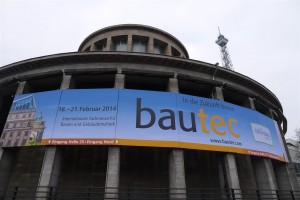
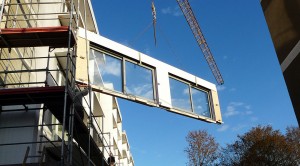
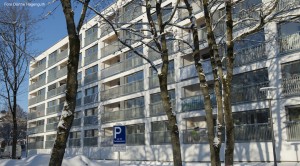
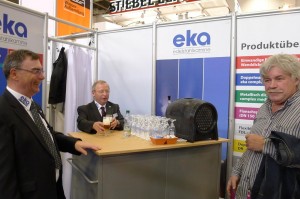
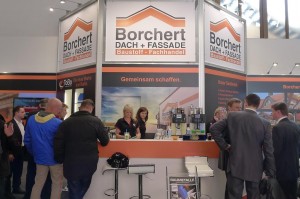
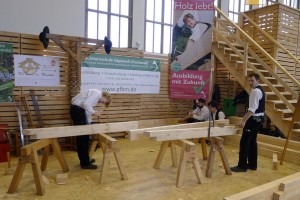
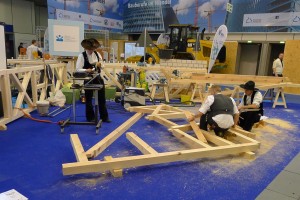
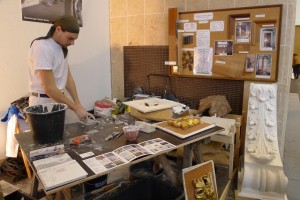
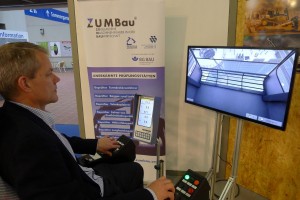
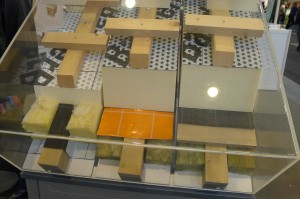
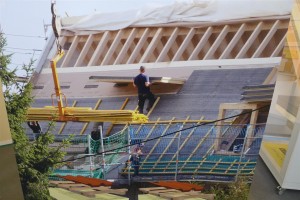
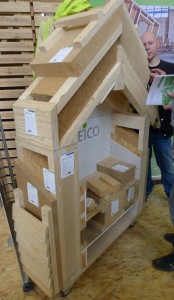
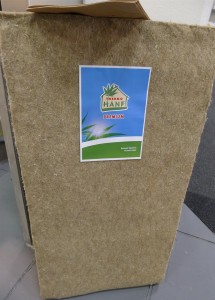
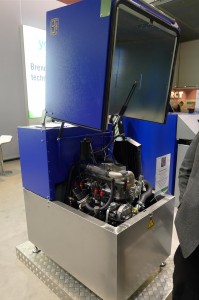
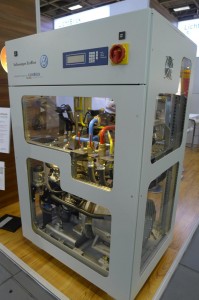
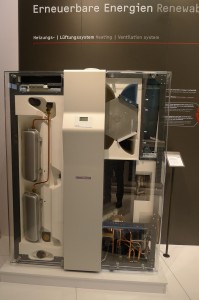
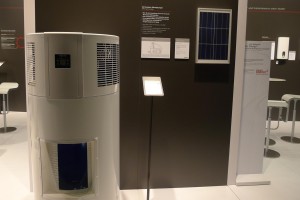
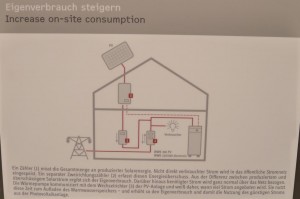
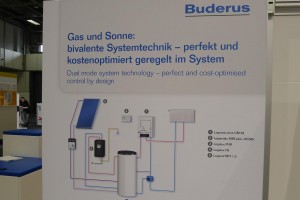
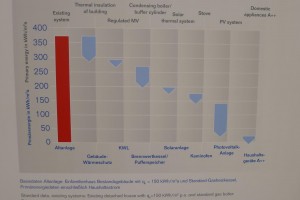
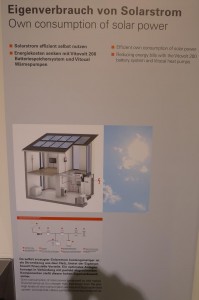
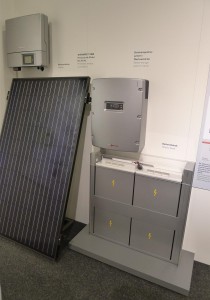
Thank you! This is so interesting.